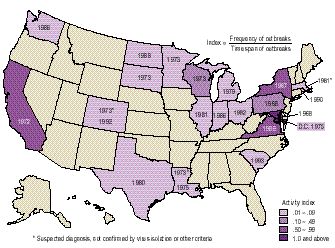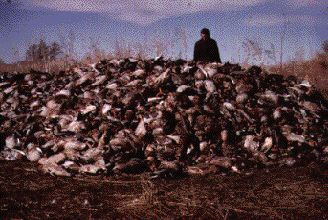Duck Plague: Emergence of a New Cause of Waterfowl Mortality
Disease-causing organisms are natural components of biological systems. Too often, however, the occurrence of disease in wildlife is directly associated with changes due to human actions. Duck plague is an example of an infectious disease of domestic waterfowl that has begun to infect migratory waterfowl populations. Our growing concern is that duck plague will soon become a major cause of death for North American waterfowl and that the threat may be heightened because actions necessary to combat duck plague appear to have become embroiled in controversy. The ensuing debate has affected both the response to outbreaks and disease prevention efforts, and it may be aiding the geographic spread of this disease.
Duck plague is an acute, contagious, and often fatal herpesvirus infection of ducks, geese, and swans (Leibovitz 1991). However, not all species of waterfowl are equally susceptible. For example, northern pintails are highly resistant, blue-winged teals are highly susceptible, and mallards are moderately susceptible. The amount of duck plague virus required to cause disease in these different species differs by orders of magnitude (Spieker 1977). Occurrence of disease is also complicated because different strains of duck plague virus vary greatly in their ability to cause disease and death (Jansen 1961; Spieker 1977).
An outbreak of an acute hemorrhagic disease of domestic ducks in the early 1920's in the Netherlands is generally believed to be the first scientific documentation of this disease (Baudet 1923). However, identification of duck plague as a distinct disease of domestic waterfowl did not occur until 1942 (Bos 1942), despite numerous outbreaks in the Netherlands from 1923 to 1942 (Jansen 1964). The name "duck plague" was proposed by Jansen and Kunst (1949) and accepted as official terminology for this disease. "Duck virus enteritis" is the name based on the principal pathological features of the disease and is used to distinguish it from fowl plague in the United States (Leibovitz 1991).
Reports of duck plague in Europe and Asia have essentially been confined to domestic waterfowl, and outbreaks with severe economic effects have occurred in those countries. Therefore, the 1967 entry of duck plague into the Pekin duck industry of Long Island, New York, (Leibovitz and Hwang 1968) quickly resulted in aggressive actions by the U.S. Department of Agriculture to eradicate this foreign animal disease. Outbreaks also occurred in upstate New York during 1967. Duck plague reached Pennsylvania and Maryland in 1968, but in 1970 the U.S. Department of Agriculture declared success in its efforts to eradicate this disease from the United States. Secretary of Agriculture Clifford M. Harden issued certificates honoring New York State agencies and the Long Island Pekin duck industry for their part in the eradication effort. "The certificates officially proclaimed the eradication of duck virus enteritis (DVE) or duck plague from commercial waterfowl in the United States" (U.S. Department of Agriculture 1970). Unfortunately, this was not the end of duck plague.
No one knows how duck plague entered the western United States. The disease, however, appeared in San Francisco in 1972 after additional outbreaks in New York, Pennsylvania, and Maryland during 1970 and 1971. A city pond at the Palace of Fine Arts was the affected site in San Francisco (Snyder et al. 1973). The following year duck plague appeared in the Midwest and by 1975 had reached the Gulf of Mexico coast (Fig. 1) and Canada (Bernier and Filion 1975). Not only has there been a continual geographic expansion of duck plague (Fig. 2), but in some regions the number of outbreaks has also increased during each

Fig. 1. Geographic distribution, spread, and relative activity of duck plague since its 1967 introduction into the United States. Years represent introduction into individual states.

decade. Increased numbers of duck plague outbreaks and deaths have occurred within the eastern United States since 1970, but outbreaks in other regions have declined during the past decade (Friend 1995). The greatest number of outbreaks has occurred in Maryland (Fig. 1); New York, Virginia, and California also have relatively frequent occurrences of this disease (National Wildlife Health Center, Madison, Wisconsin, unpublished records).
In addition to domestic ducks, small numbers of wild waterfowl and wild species being maintained in avicultural collections or free as feral birds became infected during the 1967 Long Island duck plague out-break. Collectively, more feral, captive, and wild waterfowl have become infected and survived subsequent outbreaks than have domestic ducks. The biological significance of those infections lies in the observation by Wobeser (1981) that birds surviving primary infection become carriers and potentially serve as future sources of additional duck plague outbreaks. To prevent the disease from spreading to other waterfowl populations, wildlife conservation agencies generally seek to destroy infected flocks. Infected waterfowl cannot be cured of the disease nor can disease carriers be readily detected by conventional technology.
Public opposition to the destruction of infected flocks is fueled by the fact that nearly all duck plague outbreaks occur in nonmigratory waterfowl in city parks and other public areas, or in captive flocks. Inherent human feelings for protecting animals, the beliefs that wild birds are the source for infection of urban and suburban waterfowl populations and that disease control is ineffective, and personal economic considerations are viewpoints often expressed by those opposing destruction of infected flocks. The objective of those opposing flock destruction is often to protect the individual birds surviving the outbreak. This is unfortunate since, as noted by Leibovitz (1991), the disease can best be controlled by eliminating entire infected populations.
The devastating 1973 duck plague outbreak in southeastern South Dakota at the Lake Andes National Wildlife Refuge demonstrated the negative effect that this disease can have on wild waterfowl (Fig. 3). Approximately 40,000 mallards and small numbers of other waterfowl species died. This was the first duck plague event involving a large-scale loss of wild waterfowl (Friend and Pearson 1973). Concern among the wildlife agencies responsible for managing the die-off resulted in the most aggressive actions ever taken to combat a disease outbreak in wild birds. Destruction of the large number of waterfowl that did not die from infection was considered but rejected because of arguments that methods were not available to prevent accidental dispersal of actively infected birds. It was feared that dispersed birds would initiate additional outbreaks as they relocated within other populations. Instead, the control effort focused on moving the birds from the confined area of Owens Bay at the refuge to the more open areas of the nearby Missouri River and then decontaminating the environment the birds had been removed from to kill any residual virus in the areas the birds had used. In a 6-month effort that involved approximately 90 people, researchers and refuge personnel decontaminated the environment by applying 7,000 pounds of chlorine gas, 2,000 pounds of calcium hypochlorite, and 64,000 pounds of soda ash. In addition, all dead birds that could be found were picked up daily and incinerated. Owens Bay was drained as much as possible and kept dry throughout the following summer months. The vegetation around the bay was burned, and all areas where disease-control activities took place on the refuge and other areas, including road surfaces and ice surfaces, were decontaminated. A sample of mallards was tested for exposure to duck plague and then color-marked before the birds dispersed from Owens Bay. The color marking was used to provide visible evidence of the location of birds that had dispersed so that researchers could survey their new sites for additional mortality and, if such mortality were detected, disease-control actions could begin quickly. Additionally, all workers in the area had to follow strict decontamination procedures to prevent disease spread. These unprecedented efforts are credited with minimizing the potential for additional outbreaks--there have been no occurrences of duck plague at Lake Andes since the 1973 event.

Fig. 3. During the 1973 outbreak of duck plague at Lake Andes National Wildlife Refuge in South Dakota, more than 40,000 mallards died. Courtesy M. Friend, USGS
To date, the 1973 Lake Andes outbreak and a February 1994 outbreak that killed about 1,200 wild waterfowl in the Finger Lakes region of upstate New York (National Wildlife Health Center, unpublished records) are the only major outbreaks in wild waterfowl, although the pattern of duck plague outbreaks within the United States is one of an emerging disease (Figs. 1 and 2). The interface that often occurs between migratory and nonmigratory waterfowl provides opportunity for the transmission of disease between different populations (Tables 1 and 2). The international mobility of migratory waterfowl provides a means for widely disseminating duck plague; avian cholera has provided a precedent to support this concern. An important disease of domestic poultry within the United States since at least 1867 (Rhoades and Rimler 1991), avian cholera first appeared in wild waterfowl within the United States in 1944 (Quortrup et al. 1946; Rosen and Bischoff 1949). It wasn't until the mid-1970's, however, that avian cholera emerged as a major cause of death for migratory waterfowl across the nation (Friend 1995).
| Commercial | Birds raised for consumptive markets, such as white Pekin ducks |
| Captive collections | Zoological and other collections of birds for display and research |
| Game farms | Birds raised for release for sporting programs, such as mallards |
| Feral | Nonmigratory, nonconfined waterfowl of various species |
| Nonmigratory | Resident populations of native wild species such as mallards and Canada geese |
| Migratory | North American waterfowl that breed in one geographic area and winter in another before returning to breeding grounds |
The recent emergence of new diseases and reemergence of old diseases have become a focus for increasing concerns involving human and domestic animal health. The subject of emerging diseases has captured the attention of filmmakers, as depicted by the movie Outbreak, and is the basis of popular books such as The Coming Plague (Garrett 1994). The subject has also earned extensive media coverage and has been the focus for scientific symposia, meetings, and publications. Duck plague is an emerging disease in the United States and must be addressed as such. The occurrence of this disease varies with different types of waterfowl populations. Migratory waterfowl have rarely been the primary species involved in outbreaks (Tables 1 and 2). It would be folly, when the opportunity exists to prevent it, to allow duck plague to join the ranks of avian botulism, avian cholera, and lead poisoning as another major cause of mortality for wild waterfowl.
| Waterfowl classification | Occurrence of disease | |
| Mortality events | Trends,1967-1995 | |
| Commercial | Infrequent | Decreasing |
| Captive collections | Occasional | None; sporadic |
| Game farms | Occasional | None; sporadic |
| Feral | Common | Increasing |
| Nonmigratory | Occasional | None; sporadic |
| Migratory | Rare | None; rare |
Advances in molecular biology offer new potential for the detection of duck plague carriers, allow researchers to determine the origin of individual outbreaks, and aid in the search for answers to other important questions that will help resolve public and scientific debate involving this disease. Research is needed to develop required technology and to implement methodical epizootiological investigations. The resulting information will provide wildlife management agencies with the information necessary to develop strategies to make duck plague a matter of historical record rather than a major cause of death for migratory waterfowl.
U.S. Geological Survey
Biological Resources Division
National Wildlife Health Center
6006 Schroeder Road
Madison, Wisconsin 53711
References